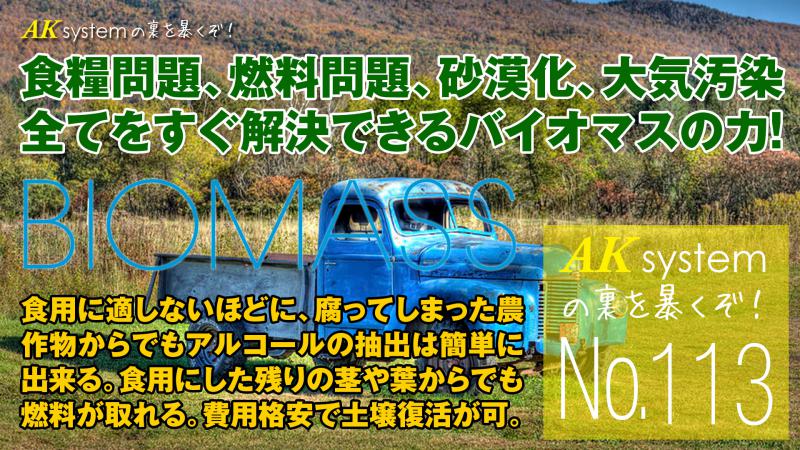バイオマスで出来る事─食糧問題、燃料問題、砂漠化、大気汚染、全てを今すぐ解決できるバイオマスの力!
2022-07-05

バイオマスでできること
有機物は何十億トンものゴミや汚泥の中にある。
アメリカの人口だけでも1秒間に1万2千ポンドの排泄物を出し、同じ1秒間にアメリカの家畜はさらに25万ポンド出している。
有害な化学物質の使用をやめ、化石燃料を燃やすのをやめ、代わりにこの塵や汚泥や土地を利用してバイオマスを作り、CO2の危険を減らし、10億人単位で増加する世界人口を養うには何が必要だろうか?
この施設は、ワシントンDCのすぐ北にあるメリーランド州の広大な土地に数百万ドルかけて建設され、納税者の負担で農民のために農業の条件を改善するよう設計されているのだ。
この特別なアプローチは、過去四半世紀の間に、チャールズ・ウォルターズ著『Acres U.S.A.』に登場する多くの専門家によって何度も提案されてきたものだ。
彼のオフィスからは、緑地の向こうに巨大な米国農務省図書館が見える。
デューク博士によれば、現在休耕している土地さえあれば、エネルギーは自給自足でき、化石燃料をこれ以上燃やす必要はないとのことである。
CHAPTER 18
Biomass Can Do It
THE ROCK DUST is there, by the billions of tons; the organic material is there in billions of tons of garbage and sludge; the U.S. population alone produces twelve thousand pounds of excrement per second, while, in that same second, U.S. livestock are producing another quarter million pounds; and there are 2 billion acres of unused or marginal land in the world, 62.5 million in the United States alone. What would it take to stop using poisonous chemicals, stop burn-ing fossil fuels, and instead create biomass with all this dust, sludge, and acreage, to thus reduce the danger of CO2, and feed a world population increasing by the billion? The answer is not the fantasy of some crackpot dreamer, but hard data spelled out by the U.S. Department of Agriculture's vast Beltsville Research Facility, a multi-million-dollar outfit spread across miles of the Maryland landscape just north of Washington, D.C., designed, at tax-payer's expense, to improve the conditions of agriculture for the farmer. Not that this particular approach hasn't been put forward before, time and again, over the past quarter century, by a series of experts writing in Charles Walters's Acres U .S.A. It is only that now the proposal comes from an official government agency, in serious form, through the lucid writing of one of its professionals, a tall, jovial Doctor of Botany and Taxonomy, James A. Duke, expert in the study of hallucinogenic plants, whose office looks out across the greensward at the enormous USDA library—an institution that fails to carry a single book by either Steiner or Kolisko! With just the acreage that now lies fallow, says Dr. Duke, we could be self-sufficient in energy and not have to burn another pound of fossil fuel.
同時に、豆類や穀物からタンパク質を大量に確保することができ、国のひどい国際収支を600億ドル改善することができるのだ。
アメリカン・インディアンの手法である、アルファルファなどの豆類とトウモロコシなどの穀物の混植を真似て、現在利用されていない土壌に「エネルギー農場」を作るだけで、これらすべてが実現するのである。
このような農場は、国民に余剰の食料を供給するだけでなく、作物から豊富な燃料を生産し、外国から原油を輸入する必要をなくすことができる。
現在、1億2千5百万エーカーの土地が干草とトウモロコシに使われているが、その90パーセントは家畜のために栽培されていることを考慮に入れずに、このようなことができる。

ジェームズ・A・デューク、ファイベータカッパ、Ph.D.
メリーランド州ベルツビルの米国農務省に長年勤務し、100以上の学術論文と、最近の『薬草ハンドブック』やビデオテープ『食べられる野生植物』(100種類の有用な野生ハーブのガイド)など数冊の著書の責任者である。
国立癌研究所がエイズ治療のために化学物質であるカスタノスペルミンの試験を行っているオーストラリア栗を手にしている。(出典:米国農務省)
At the same time we could have a large surplus of proteins from legumes and grains; and we could remedy the nation's appalling balance of payments by $60 billion. All of this simply by planting our marginal soil, all 62.5 million acres of it, and imitating the American Indian method of intercropping—legumes such as alfalfa with cereals such as corn—to create "energy farms" on soil not presently exploited. Such farms could not only feed the nation, with a surplus, but produce abun-dant fuel from crops, eliminating the need to import crude oil from abroad. And all this without taking into account the 125 million acres presently devoted to hay and corn, 90 percent of which is grown for livestock.
James A. Duke, Phi Beta Kappa, Ph.D. in Botany, has been for many years with the USDA at Beltsville, Maryland, and is responsible for over a hundred scientific publi-cations and several books, including his recent Handbook of Medicinal Herbs, and a videotape Edible Wild Plants, a guide to a hundred useful wild herbs. He is holding an Australian chestnut that is being tested by the National Cancer Institute for its chemical—castanospermine—as a therapeutic hope for AIDS. (Credit: USDA)
土の秘密
新鮮な植物組織から自動車燃料を作ることは、植物や微生物の化石から作るのと同じくらい簡単である。
しかし、植物には、再生可能、年単位、不特定多数に利用できるという大きな利点がある。
新鮮な植物から、ガソリンやディーゼル燃料に代わる低公害の燃料が経済的に入手できる。
この燃料は、ガソリンや軽油に代わる経済的な低公害燃料であり、産業界が排出するCO2を削減し、温室効果を大幅に低減することができる。
同時に、植物が大量に発生し、その余剰分を吸収し、温室効果をさらに相殺する。
また、有機性廃棄物は荒廃した土壌を再生するのに役立つ。
アルファルファは涼しい時期によく育ち、1エーカーあたり石油2〜7バレル分のエネルギーが得られるとデューク氏は言う。
アルファルファの平均的な収穫量から推定すると、アルファルファ1エーカーあたり1トン近くの食用葉タンパク質を得ることができるとデュークは結論付けた(これはハロルド・アウンスト氏がソニックブルームを使って得た量のわずか7分の1である)。
「豆科植物と穀類を混作するのがコツです」とデューク。
確かに穀物だけを栽培すれば、より多くの穀物を得ることができますし、豆類だけを栽培すれば、より多くの豆類を得ることができます。
しかし、この2つを一緒に栽培すれば、より大きなバイオマスを得ることができ、それがあなたの目指すところです。
トウモロコシは、夏の暑い時期に最もよく光合成を行うC-4と呼ばれるカテゴリーに属する、より生産性の高い植物の1つである。
太陽の光によって、茎と葉だけで1エーカーあたり20バレルの石油に相当するエネルギーを生産し、さらに穀物をエネルギーとして利用すれば6バレルのエネルギーが得られる。
これだけの生産量を確保するために必要な石油は1エーカーあたり2バレル、そのうち1バレル近くは窒素肥料に使われる。
しかし、アルファルファは他のマメ科植物と同様、窒素を大気中から取り込み、1エーカーあたり約200ポンドの割合で土壌に入れるので、必要な1バレルの石油を余裕で補うことができる。
その他、燃料生産性の高いC-4植物としては、米、ソルガム、そしてウェス・ジャクソンが「ザ・ランド」で改良しているような高草原がある。
現在、6250万エーカーの休耕地から得られる5500万トンのタンパク質は、アメリカ人の食生活に必要な量の約10倍にもなる。
また、タンパク質を抽出した後の残渣から、セルロースを糖分に分解したアルコールとして、年間2億5千万バレルの石油を生産することができる。
これだけで、ペルシャ湾からの石油輸入を大幅に削減でき、危険な海域のパトロールも不要になる。
デューク氏は、このファイファー氏の夢を実現するために、6,250万エーカーのトウモロコシやアルファルファに下水汚泥を施肥すれば、現在1日に700万バレル近く輸入している石油を100万バレル減らせるかもしれない、と言っているのである。
すでに1979年には、ダン・カールソンという人が、アメリカ国防総省に提案をしている。
SECRETS OF THE SOIL
To make auto fuel from fresh plant tissue is just as easy as making it from the fossilized remains of plants and microorganisms. But plants have an enormous advantage: they are renewable, yearly and indefi-nitely. From fresh plants low-pollution fuel is economically available to replace both gasoline and diesel fuel. This would greatly reduce the greenhouse effect by cutting down on the industrial proliferation of CO2. At the same time it would create a great mass of vegetation to absorb the present surplus, further offsetting the greenhouse effect. Organic wastes from all this bonanza would help rebuild a degraded soil. Alfalfa, says Duke, grows well in the cool months, producing enough vegetation per acre to yield the energy equivalent of two to seven barrels of oil. Basing estimates on average alfalfa yields, Duke concludes that we could get nearly a ton of edible leaf protein per acre of alfalfa (and that's only one-seventh of what Harold Aungst was able to get using Sonic Bloom). "The trick," said Duke, "is to intercrop a legume with a cereal. True, if you grow grain alone, you'll get more grain; and if you grow legume alone you'll get more legume. But if you grow the two together you'll get a greater biomass, and that is what you're after." Corn is one of the more productive plants, in a category known as C-4, which photosynthesize best in the heat of summer. With the aid of sunshine, its stalks and leaves alone produce the energy equivalent of twenty barrels of oil per acre, plus another six barrels from the grains if these are used for energy. To achieve this output requires only two barrels of oil per acre, nearly one barrel of which goes for nitrogen fertilizer. But alfalfa, like most legumes, takes nitrogen from the atmo-sphere and puts it into the soil at the rate of about two hundred pounds per acre, comfortably compensating for the one required barrel of oil. Other highly fuel-productive C-4 plants include rice, sorghum, and the taller grasses, such as those that Wes Jackson is improving at "the Land." The 55 million tons of protein derivable from the 62.5 million acres now lying fallow would be about ten times what Americans need for their diet. The residues remaining after protein extraction would yield the yearly equivalent of 250 million barrels of oil in the form of alcohol from the cellulose broken down to sugar. This alone could significantly cut oil imports from Persian Gulf countries, and eliminate the need foi'patrol-ling dangerous waters. Revitalizing Pfeiffer's dream, Duke suggests that, if we were to fertil-ize with sewage sludge, our 62.5 million acres of corn and alfalfa could probably reduce imports by one million barrels of oil a day, from our present daily import of nearly seven million barrels. Already in 1979 Dan Carlson had submitted a proposal to the Depart-
葉や茎を除いたトウモロコシの粒だけから得られる燃料の年間生産量を、通常の250ガロンから650ガロンに増やし、場合によっては1年に2回収穫して、年間1,000ガロン以上を再生可能にすることを、エネルギー省のソニックブルームで提案した。
しかし、DOEは、当選したばかりのロナルド・レーガンによって頓挫させられそうになりながら、この悲観的な提案に対する正式な評価を下すことはなかった。
しかし、まだ1億2千5百万エーカーの土地が残っている。
現在、家畜用の干し草やトウモロコシの栽培に使われているか、あるいは間違って使われている。
もし、これらの緑の土地を、豆類と穀類を適切に組み合わせた「エネルギー農場」にすることができれば、デューク氏によれば、1億トンの豆類タンパク質を地元消費と輸出のために収穫した後、これまで収穫したことがないほどのトウモロコシ穀物を生産し、残渣から35億バレルの石油を生産することができます。
これで、日本が必要とするすべてのエネルギーをまかなうことができる。
そして、それ以上に魅力的なのは、その他のメリットだ。
有機農法で自給自足が可能になれば、不況にあえぐ農業、住宅産業、自動車産業に雇用が生まれるとデューク氏は言う。
エネルギー作物を植え、栽培し、収穫し、加工するために、より多くの人手が必要になる。
エネルギー作物をエタノール(穀物アルコール)、メタノール(木質アルコール)、メタンガスなど、ガソリンよりも汚染度の低い再生可能燃料に変換するために、エネルギー農場の近くに小さな工場が必要になるだろう。
デトロイトは、再生可能燃料で車を走らせるために必要なコンバーターを製造することで、不況を脱することができるとデューク氏は言う。
燃料の製造工程を分散化し、地球の裏側まで燃料を運ばないようにすれば、燃料輸送のエネルギーを節約しながら、落ち込んだ地域経済を活性化することができる。
有機的な再生可能燃料に転換することで、OPECのためでなく、アメリカのための研究と雇用を生み出すことができるのです。
そうすれば、アメリカの農家が長年抱いてきた「1ブッシェルのトウモロコシと1バレルの石油を交換する」という夢も叶うかもしれない。
ロサンゼルスやデンバーの空気は、再び呼吸に適したものになるかもしれない。
そして、アリゾナ州などでは水不足が深刻化している。
エネルギー問題に対処するために、現在、西部の水域を大量に使用することが求められている。
米国では現在、水の半分以上が不経済な畜産に使われており、1ポンドの肉を生産するのに2,500ガロンの水が必要である。
ジョン・ロビンズは、『新しいアメリカのための食事』の中で、このことは一般家庭の食卓のコストに影響すると言っている。
ment of Energy offering with his Sonic Bloom to increase the annual production of fuel derivable from an acre of corn grain alone (without the leaves or stalks) from a normal 250 gallons to a bumper 650, and possibly achieve two crops in a year, which would comfortably raise the flow to over 1,000 gallons, renewable annually. But DOE, in the throes of nearly being aborted by the newly elected Ronald Reagan, never made an official assessment of this sanguine proposal. Yet there still remains the patrimony of 125 million acres to work with, presently used, or misused, to grow hay and corn for livestock. Were these green acres to be made into `,energy farms" of appropriate combinations of legumes and cereals, we could, according to Duke, after harvesting for local consumption and for export of 100 million tons of legume protein, produce more corn cereal than we have ever harvested before, and generate 3.5 billion barrels of oil from the residue. This would take care of the country's entire energy requirements. And just as appealing are all the other benefits accrued. In becoming self-sufficient via organic energy farms, we could, says Duke, generate employment for the depressed farming, housing, and automotive indus-tries. More hands would be needed to plant, cultivate, harvest, and pro-cess energy crops. Small factories would be needed near the energy farms to convert energy crops into renewable fuels like ethanol (grain alcohol), methanol (wood alcohol), and methane gas, all of which generate less pollution than gasoline. Detroit, says Duke, could reverse its slump by manufacturing con-verters needed to run our cars on renewable fuels. Decentralizing the fuel-production process, eliminating the transport of fuel halfway around the world, would stimulate depressed local economies while conserving energy in fuel transport, to say nothing, adds Duke with a smile, of removing the oil producers' fingers from our economic throats. By converting to organic renewable fuels, we would generate research and jobs for America rather than for OPEC. Price shifts following such a conversion might make it possible to fulfill the long-held dream of U.S. farmers of trading a bushel of corn for a barrel of oil. Air in Los Angeles and Denver might once more be fit to breathe. And then there is the problem of water, becoming increasingly scarce in such states as Arizona. Current efforts to deal with our energy problems call for massive use of western waters—water that will be needed by farmers to grow their crops. More than half the water used in the United States now goes to uneconomic livestock production, 2,500 gallons being needed to produce one pound of meat. This, says John Robbins in his eye-opening Diet for a New America, would make the cost of common
もし、食肉産業が使用する水がアメリカの税金で賄われていなかったら、ハンバーガー肉は1ポンドあたり35ドルになっていただろう。
オーガニック・エネルギー農場は、水とエネルギーの両方の問題を解決することができるとデュークは言う。
作物をエネルギーやタンパク質に加工する際に除去される水を、パイプで畑に戻すことができるのです。
また、西部の乾燥した畑に腐葉土が蓄積されれば、少ない雨をためることができる。
もうひとつ、デューク氏が提案するのは、採掘機で掘り起こした土地をエネルギー農場として活用することだ。
採掘した石炭を運び出し、下水汚泥を運び込んで肥料にし、土地を再生させる。
やがて、バージ船は再生可能燃料を都心に運び、汚泥をエネルギーファームに運ぶようになるだろう、とデューク氏は言う。
1960年代にはすでに、経済学者で産業界の顧問でもあったドナルド・デスペインが、農業を単なる食糧供給源から工業製品の供給源に転換し、アメリカでかつて経験したことのないほどの農民の繁栄を実現するための根本的な新産業を提案していたのだ。
「農業は長い不況に突入し、農家は20年前と同じ値段で(作物を売り)、しかも3倍も高い値段で買わさる電力用に(発電用の)アルコール用の作物を栽培すれば、不況を脱し、繁栄への道が開ける」と1972年に聴衆に語っている。
デスパイネは、ダウ・ケミカル社の幹部、ウィリアム・S・ヘイルが米国上院の農業小委員会で語ったことを引用した。
「アルコールは、砂糖の結晶を含むあらゆる農産物から製造することができ、余分な農産物の唯一の大量生産が可能である」と。
では、内燃機関がアルコールを単独燃料として、あるいはガソリンにアルコールを添加し、ガソリンの代用として、あるいはガソリンを100%伸ばして運転できることが半世紀以上も前から知られ、証明されているのに、なぜ、この大当たりを誰もが利用できないのだろうか。
1930年代にレオ・M・クリステンセン博士が『パワーアルコールと農業救済』というパンフレットの中で、エチルアルコールをすべての燃焼エンジンの安価な燃料として使用することについて、広範な科学文献を深く掘り下げている。
その結果、経済的な見地からアルコール燃料が最も優れており、しかも石油は輸入しなければならないが、アルコールは自国内で生産できることがわかった。
農家にとって最も魅力的なのは、自分たちの農場で燃料を蒸留できること、また、砂糖やデンプンを含むあらゆる作物を処理できる共同蒸留機で1日1万ガロンもの大量の燃料を作ることができることであった。
hamburger meat $35 per pound were the water used by the meat industry not subsidized by the U.S. taxpayer. The organic energy farm, says Duke, will alleviate both water and energy problems. Water removed during processing of crops for energy and protein can be piped back to the fields. In addition, the buildup of humus in dry western fields would help to hold the scanty rain. Another creative way of turning a disaster area to advantage is Duke's suggestion that strip miners convert the torn-up land into energy farms, intercon-nected by canals dug with their earth-gouging machinery. Stripped coal could then be barged out, and sewage sludge barged in to fertilize and rehabilitate the land. Before long, says Duke, barges would be hauling renewable fuels to urban centers and sludge back to the energy farms, bringing a knowing smile to Pfeiffer's ghost. As early as the 1960s, Donald Despain, a maverick economist and industrial-relations counsel, had proposed a fundamentally new industry to transform agriculture from only a source of food supply to a supplier of industrial products, which would create a degree of agrarian prosperity never before experienced in America. "With agriculture entering a long depression," he told audiences in 1972, "and farmers getting the same prices they got nearly twenty years ago—while paying prices three times higher—their growing crops for power alcohol could pull them out of a slump and into prosperity." Despain quoted a Dow Chemical Company executive, William S. Hale, as telling the U.S. Senate's Subcommittee on Agriculture: "Alco-hol, which can be manufactured from any farm product containing sugar crystals, is the only outlet in mass form we have for excess agricul-tural products." So, why is it, if the fact has been known and proved for over half a century that internal-combustion engines can run on alcohol as a sole fuel or on gasoline with an alcohol additive, either substituting for gaso-line or stretching it by 100 percent, that this bonanza is not available to one and all? In the 1930s Dr. Leo M. Christensen in a pamphlet, Power Alcohol and Farm Relief, dug deeply into the extensive scientific literature on the use of ethyl alcohol as a cheap fuel for all combustion engines. All the investigators agreed that from the standpoint of national economic wel-fare alcohol was the best fuel because of its many established advantages, plus the fact that it could be produced within each country, whereas petroleum usually has to be imported. Most attractive to farmers was the chance to distill their own fuel on their own farms, or make larger amounts—as much as ten thousand gallons a day—in a community distiller, which could process any crop containing sugar or starch.
バイオマスならできる
石油会社の反対は組織的で残忍だった。
彼らは、アルコールは非効率的で危険であると国民を脅すために、ガリ版刷りの資料を全国の給油所経営者に無料で配り歩いたとクリステンセンは言う。
各州に支部を持つ石油協会が動き出し、首都では、上院議員や下院議員にロビー活動をするための資金が石油のように湧き出していた。
「農民のアルコール」のために果敢に戦ったチャールズ・ウォルターズ・ジュニアは、「ビッグ・オイル」カルテルのメンバーが、穀物の蒸留、それも人間が消費できないほど腐った穀物の蒸留に激しく反対し、さらに第二次世界大戦でアメリカとその連合国の生存がかかっていたときでさえ、戦前、戦中、戦後の一連の記事で慎重に記録しています。
FDRのバルーク委員会の命令で、B-29爆撃機は100プルーフのハイオクを混合したアルコールで飛行するようになった。
しかし、米国農務省農産化学局長のヒルベルト博士が、「農産アルコールはレギュラーガソリンと同等の低オクタン価燃料を作る」と報告し、余剰穀物の膨大な市場を経済的に提供できると強調したのに、政府は戦後すぐにアルコール精製所を閉鎖してしまったのである。
10億ブッシェルの余剰穀物を蒸留するのに必要な費用は3千万ドルで、穀物貯蔵所の増設に必要な2億ドルに比べれば微々たるもので、「問題解決にはならない」と彼は言った。
穀物が大箱、エレベーター、空き地、テント、船、さらには町の大通りにまで貯蔵され、1ブッシェルあたり21/2ガロンという、プレミアムガソリンよりも優れたエチルアルコールを含んでいる一方で、農家は土地を手放すために補助金をもらっていたのである。
トルーマンの農務長官チャールズ・F・ブラナンもアルコールへの移行を支持し、農務省の専門家はある上院議員に、傷んだ穀物をすべて工業用アルコール製造に使えない理由はないと語った。
しかし、1952年にドワイト・アイゼンハワーが当選すると、彼は退任直前に警告した軍産の大物として、戦後のアメリカ農業のあり方を検討する特別委員会が設置された。
ロシア、ポーランド、イタリア、フランス、イギリスでの75年にわたるアルコールの経験をあからさまに無視し、委員会は「現在の知識と経済状況の下では、自動車燃料に工業用アルコールを使用することは正当化できると信じるに足る根拠はない」と結論づけたのである。
これは、ラス・タヌラをはじめとするサウジアラビアの製油所では、石油が1バレル4.6セントで手に入ることを前提にした、根拠のない発言であった。
しかし、ウォルターズ氏は、「アルコールはガソリンと同じパワーがあり、燃焼もクリーンで、排気ガスも少なく、燃料としての異常もない」と言い切った。
Opposition of the oil companies, says Christensen, was organized and brutal: they went about distributing to filling-station operators across the nation cost-free mimeographed material to scare the public into believ-ing that alcohol was inefficient or dangerous. The Petroleum Institute, with branches in every state, went into action, and in the nation's capital money gushed like oil to lobby senators and congressmen. Intrepidly fighting for the "Farmer's Alcohol," Charles Walters, Jr., carefully documented in a series of articles in Acres U.S.A. the cynical attitude of the "Big Oil" cartel members before, during, and since World War II, as they fought bitterly against the distillation of grain, even grain so spoiled as to prevent its consumption by humans, and even when survival of America and its Allies was at stake in World War II. Only on orders from FDR's "no red tape" Baruch Committee, did B-29 bombers eventually fly on a mixture of high-octane 100-proof alcohol. But right after the war the government closed down its alcohol refineries, even though Dr. G. E. Hilbert, Chief of the USDA's Bureau of Agricultural and Industrial Chemistry, reported, on the basis of extensive testing, that "farm alcohol makes low-octane fuel equal to regular gasoline," empha-sizing that it could economically provide a vast market for surplus grains. To distill a billion bushels of surplus grain, he said, cost only $30 million —a small amount compared to the $200 million required to build in-creased grain storage facilities, "which in no way solve the problem." While grain was being stored in bins, elevators, vacant lots, tents, ships, and even on the main streets of towns, each bushel of grain con-taining better than 21/2 gallons of ethyl alcohol, superior to premium gasoline, the farmer was being subsidized to retire land. The move to alcohol was even supported by Truman's Secretary of Agriculture, Charles F. Brannan; and a USDA expert told one U.S. Senator there was no reason why all damaged grain could not be used for producing industrial alcohol. But, when Dwight D. Eisenhower was elected in 1952—as .doyen of the military-industrial establishment, the machinations of which he warned against just before leaving office—a special commission was formed to look at American postwar agriculture. Blatantly ignoring seventy-five years of alcohol experience in Russia, Poland, Italy, France, and England, the commission concluded that it had found "no encouragement for believing that, in the present state of knowledge and under present economic conditions, the use of industrial alcohol for motor fuel can be justified." It was a specious statement predicated on oil's being available at 4.6 cents a barrel at Ras Tanura, and other Saudi Arabian oil refineries, ad infinitum. Whereas the commission used the excuse that alcohol was not effi-cient as a fuel, Walters pointed out that it is equivalent to gasoline in power, burns cleaner, produces lower emissions, and causes no unusual
続きは…
https://keen-area.net/2022/921/
このサイトは独立したサイトでありいかなる企業とも提携していません。完全に自己資金により運営されています。
もしあなたがこのサイトの記事を良いとお考えでしたら、是非ともサポートをお願い致します。どんなに少額のサポートでも活動には有益です。
以下のリンクから、クレジットカードあるいはアマゾンペイ(コンビニ購入可能)、ペイパルでも支払い可能なサポート送金システムがあります。勿論個人情報の記載は不要です。
https://doneru.jp/AK-system
2252 : PV
関連記事
コメント一覧







